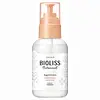What's inside
What's inside
 Key Ingredients
Key Ingredients

 Benefits
Benefits

 Concerns
Concerns

 Ingredients Side-by-side
Ingredients Side-by-side

Dimethicone
EmollientHydrogenated Polyisobutene
EmollientParaffinum Liquidum
EmollientCetyl Ethylhexanoate
EmollientIsononyl Isononanoate
EmollientDiphenylsiloxy Phenyl Trimethicone
Skin ConditioningPrunus Amygdalus Dulcis Oil
Skin ConditioningArgania Spinosa Kernel Oil
EmollientOlea Europaea Fruit Oil
MaskingCarthamus Tinctorius Seed Oil
MaskingTocopherol
AntioxidantAscorbyl Palmitate
AntioxidantRibes Nigrum Fruit Oil
PerfumingSimmondsia Chinensis Seed Oil
EmollientMacadamia Ternifolia Seed Oil
EmollientBHT
AntioxidantOlive Acid
Caprylic/Capric Triglyceride
MaskingEthylhexyl Methoxycinnamate
UV AbsorberPhenoxyethanol
PreservativeParfum
MaskingDimethicone, Hydrogenated Polyisobutene, Paraffinum Liquidum, Cetyl Ethylhexanoate, Isononyl Isononanoate, Diphenylsiloxy Phenyl Trimethicone, Prunus Amygdalus Dulcis Oil, Argania Spinosa Kernel Oil, Olea Europaea Fruit Oil, Carthamus Tinctorius Seed Oil, Tocopherol, Ascorbyl Palmitate, Ribes Nigrum Fruit Oil, Simmondsia Chinensis Seed Oil, Macadamia Ternifolia Seed Oil, BHT, Olive Acid, Caprylic/Capric Triglyceride, Ethylhexyl Methoxycinnamate, Phenoxyethanol, Parfum
Water
Skin ConditioningStearyl Alcohol
EmollientParaffinum Liquidum
EmollientCetyl Alcohol
EmollientGlycerin
HumectantHorse Fat
Skin ConditioningCamellia Sinensis Callus
AntimicrobialSteartrimonium Bromide
PreservativeStearoxypropyltrimonium Chloride
CleansingDimethicone
EmollientCyclopentasiloxane
EmollientTrideceth-3
EmulsifyingC12-14 Pareth-5
CleansingPolyquaternium-10
Hyaluronic Acid
HumectantHydrolyzed Silk
HumectantCetyl-Pg Hydroxyethyl Palmitamide
Skin ConditioningArginine
MaskingButylene Glycol
HumectantCitric Acid
BufferingEthylparaben
PreservativeParfum
MaskingWater, Stearyl Alcohol, Paraffinum Liquidum, Cetyl Alcohol, Glycerin, Horse Fat, Camellia Sinensis Callus, Steartrimonium Bromide, Stearoxypropyltrimonium Chloride, Dimethicone, Cyclopentasiloxane, Trideceth-3, C12-14 Pareth-5, Polyquaternium-10, Hyaluronic Acid, Hydrolyzed Silk, Cetyl-Pg Hydroxyethyl Palmitamide, Arginine, Butylene Glycol, Citric Acid, Ethylparaben, Parfum
Ingredients Explained
These ingredients are found in both products.
Ingredients higher up in an ingredient list are typically present in a larger amount.
Dimethicone is a type of synthetic silicone created from natural materials such as quartz.
What it does:
Dimethicone comes in different viscosities:
Depending on the viscosity, dimethicone has different properties.
Ingredients lists don't always show which type is used, so we recommend reaching out to the brand if you have questions about the viscosity.
This ingredient is unlikely to cause irritation because it does not get absorbed into skin. However, people with silicone allergies should be careful about using this ingredient.
Note: Dimethicone may contribute to pilling. This is because it is not oil or water soluble, so pilling may occur when layered with products. When mixed with heavy oils in a formula, the outcome is also quite greasy.
Learn more about DimethiconeParaffinum Liquidum is also known as liquid paraffin. It is a type of highly refined mineral oil.
Like other oils, Paraffinum Liquidum has emollient properties. Emollients help soothe and soften the skin. By creating a barrier to trap moisture within, emollients help keep your skin hydrated.
Paraffinum Liquidum does not irritate the skin and is non-comedogenic.
Learn more about Paraffinum LiquidumParfum is a catch-all term for an ingredient or more that is used to give a scent to products.
Also called "fragrance", this ingredient can be a blend of hundreds of chemicals or plant oils. This means every product with "fragrance" or "parfum" in the ingredients list is a different mixture.
For instance, Habanolide is a proprietary trade name for a specific aroma chemical. When used as a fragrance ingredient in cosmetics, most aroma chemicals fall under the broad labeling category of “FRAGRANCE” or “PARFUM” according to EU and US regulations.
The term 'parfum' or 'fragrance' is not regulated in many countries. In many cases, it is up to the brand to define this term.
For instance, many brands choose to label themselves as "fragrance-free" because they are not using synthetic fragrances. However, their products may still contain ingredients such as essential oils that are considered a fragrance by INCI standards.
One example is Calendula flower extract. Calendula is an essential oil that still imparts a scent or 'fragrance'.
Depending on the blend, the ingredients in the mixture can cause allergies and sensitivities on the skin. Some ingredients that are known EU allergens include linalool and citronellol.
Parfum can also be used to mask or cover an unpleasant scent.
The bottom line is: not all fragrances/parfum/ingredients are created equally. If you are worried about fragrances, we recommend taking a closer look at an ingredient. And of course, we always recommend speaking with a professional.
Learn more about Parfum